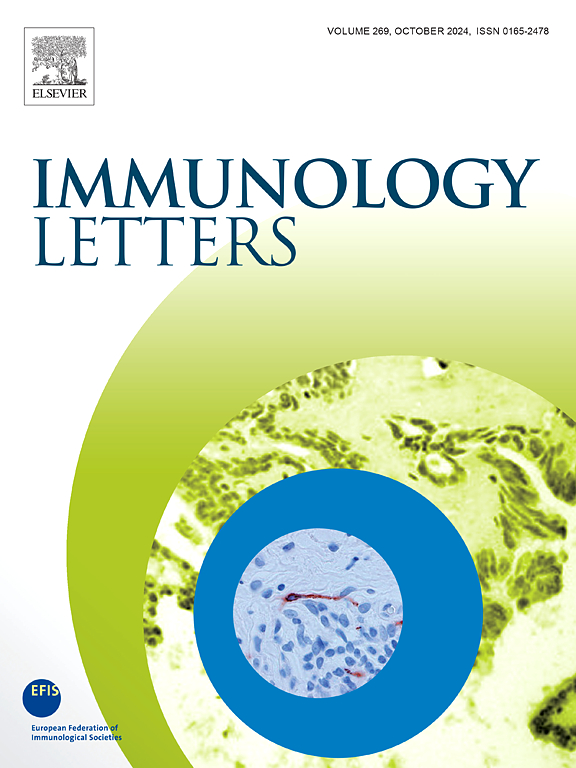建立一个系统来识别免疫系统成分之间的相关性,探索免疫信息传递的替代途径。
IF 2.8
4区 医学
Q3 IMMUNOLOGY
引用次数: 0
摘要
经典的免疫系统信息传递是通过细胞间的直接接触和介质的分泌来实现的。然而,某些免疫现象表明,在独立于这些常规机制的免疫成分之间存在替代途径。方法:选取24只雄性C57Bl/6J小鼠,分为6组,建立免疫信息传递替代途径检测系统。脾切除术和24小时禁食两种触发法以不同的组合应用。取手术后小鼠脾细胞,置于不同处理组笼内无菌管中。体外淋巴细胞反应采用荧光活化细胞分选(FACS)检测细胞表位表达(CD4、CD8、CD25、Foxp3),酶联免疫吸附法(ELISA)检测细胞因子分泌(IFN-γ、TNF-α、IL-10、TGF-β)。结果:应用触发剂后,CD25和CD8+CD25的表达以及IL-10的分泌发生了显著变化。该系统表现出固有的可变性,在与暴露于触发器的动物没有直接接触的分离脾细胞中,有改变免疫反应的趋势。非参数分析表明了这些标记物的趋势,尽管在组内存在显著的差异。结论:数据表明免疫成分之间的相关性可能通过其他途径发生,表明免疫系统中非传统信息传递机制的可能性需要进一步研究。本文章由计算机程序翻译,如有差异,请以英文原文为准。
Establishing a system to identify correlations among immune system components for exploring alternative pathways for immune information transfer
Introduction
The classic immune system information transfer occurs through direct cell-to-cell contact and the secretion of mediators. However, certain immune phenomena suggest alternative pathways exist between immune components that operate independently of these conventional mechanisms.
Methods
We used 24 male C57Bl/6 J mice, divided into six groups, to establish a system for testing alternative immune information transfer pathways. Two triggers—splenectomy and 24-hour fasting—were applied in various combinations. Splenocytes were prepared from operated mice and placed in sterile tubes within cages of different treatment groups. Ex vivo lymphocyte responses were measured using fluorescence-activated cell sorting (FACS) for cell epitope expression (CD4, CD8, CD25, Foxp3) and enzyme-linked immunosorbent assay (ELISA) for cytokine secretion (IFN-γ, TNF-α, IL-10, TGF-β).
Results
Significant changes were observed in CD25 and CD8+CD25 expression, as well as in IL-10 secretion, following the application of the triggers. The system exhibited inherent variability with trends toward altered immune responses in isolated splenocytes that had no direct contact with the trigger-exposed animals. Non-parametric analysis indicates a trend for these markers, even though there is significant variability within the groups..
Conclusions
The data suggest a system where correlations between immune components may occur through alternative pathways, indicating the possibility of non-conventional information transfer mechanisms in the immune system that require further investigation.
求助全文
通过发布文献求助,成功后即可免费获取论文全文。
去求助
来源期刊

Immunology letters
医学-免疫学
CiteScore
7.60
自引率
0.00%
发文量
86
审稿时长
44 days
期刊介绍:
Immunology Letters provides a vehicle for the speedy publication of experimental papers, (mini)Reviews and Letters to the Editor addressing all aspects of molecular and cellular immunology. The essential criteria for publication will be clarity, experimental soundness and novelty. Results contradictory to current accepted thinking or ideas divergent from actual dogmas will be considered for publication provided that they are based on solid experimental findings.
Preference will be given to papers of immediate importance to other investigators, either by their experimental data, new ideas or new methodology. Scientific correspondence to the Editor-in-Chief related to the published papers may also be accepted provided that they are short and scientifically relevant to the papers mentioned, in order to provide a continuing forum for discussion.
 求助内容:
求助内容: 应助结果提醒方式:
应助结果提醒方式:


